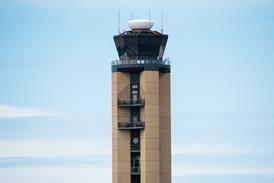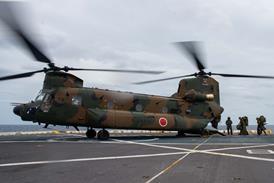NICHOLAS IONIDES / SINGAPORE
Asian airlines have been riding an economic rollercoaster - but there are signs that the worst of may finally be over
It seems that every other two years, the biennial Asian Aerospace show is set against a negative backdrop. When the world aerospace community met in Singapore for Asian Aerospace 2000, the feeling was quite positive, with the Asian industry recovering well from a regional economic downturn.
The mood around Asian Aerospace 1998 was vastly different, however. In mid-1997 Thailand devalued the baht, setting into motion a wave of economic depression, as East Asia's heavily indebted "tiger economies" faltered.
That led to radical cuts by many of the region's airlines, resulting in plans for aircraft orders being dropped, widespread order deferrals and cancellations, and an overall fleet reduction by some major carriers. Those players most badly affected by the downturn in economic fortunes, such as Garuda Indonesia and Philippine Airlines, still have much smaller fleets than they had in 1997.
As the industry prepares to meet in Singapore for Asian Aerospace 2002, the bad times are back with a vengeance. And this time they are affecting not only Asia, but the entire world.
While Asian carriers have for the most part not been as badly affected by the post-11 September drop in passenger traffic as their counterparts in Europe and the USA, they have seen a sharp decline in demand. Most have responded by shifting capacity from long-haul services and putting it back into Asia, where traffic is holding up better.
Better positioned
Some in the region argue that Asia's carriers were in a better position to cope with the post-September downturn than their battered counterparts, as traffic was already weak in the months before the attacks on the USA.
As the US economy began to weaken early last year, and the troubled Japanese economy continued to limp along, exports of electronic goods fell sharply. For some markets like Singapore and Taiwan, IT-related exports were down as much as 40% each month from the start of 2001. "We really started seeing things falling apart in the second half of 2000," says one executive with a major Asian airline. "We could see that cargo was dropping off - and it was clear that passenger traffic was going to start suffering around six months later. Unfortunately, we were right."
Peter Harbison, managing director of Australia-based consultancy the Centre for Asia-Pacific Aviation, says that, in the long term, the downturn will not have a huge impact on aircraft ordering.
Some observers believe the events of 11 September have changed the face of the industry for good. However, apart from making people more afraid of air travel, it may be that they have also revealed deeper problems, and that airlines and infrastructure providers should shift their focus.
Harbison believes 11 September has highlighted fundamental issues that should, at least in the medium term, be addressed by Asian airlines, governments and airport operators. Given that the slump has led to many carriers increasing intra-Asia flights where business has held up relatively well, some airlines' strategies may be set to change for good.
Harbison says investment plans may have to be reworked, and some airports with ambitions for key-hub status should now be focusing attention more on developing point-to-point traffic.
This view is not accepted by all, however - and in some ways it reinforces the difference in outlook between Airbus and Boeing. For example, Airbus, which has traditionally relied less on sales from Asia than Boeing, expects far more ultra-large aircraft to be ordered over the next 20 years, with many being sold to Asian carriers. Boeing expects more point-to-point traffic growth to secondary destinations by-passing major hubs, such as Hong Kong, Singapore and Tokyo. Clearly, Asia will be a key battleground in the fight to prove which manufacturer is right.
At the start of 1997, six months before the Asian downturn struck, nearly one in every five aircraft in the backlog of Airbus and Boeing was for an East Asian carrier. Two years later that proportion had been cut sharply - for Boeing the East Asian order backlog fell to around 12% in 1999 from 19% in 1997, and for Airbus it fell to around 7% from 18%, for the same period.
And there has been no return to pre-1997 levels. As of January 2000, Boeing's backlog from East Asia accounted for around 12% of the total, and it was roughly the same a year later. Now it stands at around 14%, according to Airclaims' CASE database.
By comparison, Airbus's backlog from East Asia made up just over 7% of the total as of the start of 2000. It was around the same in January last year, and now stands at around 8.5%.
Analysts say, however, that this should change again, since Asia's economies will undoubtedly return to solid growth at some point. Growth in gross domestic product (GDP) is a key indicator, and forecasts are generally upbeat for that.
Boeing forecasts that world GDP will grow by an average of 3% annually over the next 20 years, but in developing regions it "may average well over 4%".
According to the US manufacturer, China is expected to have the fastest GDP growth in the world, at 6.1%, as it continues adapting its planned economy to world trends. South-East Asia's GDP will also grow significantly faster than the world average, at 4.8% - though "not at the high levels experienced during the 1990s when its economies were less mature."
Traffic growth
Boeing and others still firmly believe Asia will see solid traffic growth again. The manufacturer expects that over the next two decades North America's market share of world traffic will fall to 19% from 25%, while that of the Asia-Pacific region will increase to 19% from 14%.
Boeing also expects air travel growth for South-East Asia's carriers to average 5.3% per year over the 20-year period, with 6.4% growth within the region.
One key point the downturn has highlighted is that domestic traffic in Asian countries has held up surprisingly well - in part because passengers are avoiding long-haul trips. This augurs well for the world's major aircraft manufacturers - particularly for sales of single-aisle jet and smaller regional aircraft.
Domestic traffic in China, for example, continued growing at double-digit rates last year, and with the country's recent entry into the World Trade Organisation, this is expected to remain strong with a predicted increase in trade with its partners.
Indonesia, meanwhile, which was worst affected by the Asian downturn of 1997-1999, has seen a boom in domestic passenger traffic following deregulation that has led to the launch of many new airlines.
A report by Indonesia's Central Bureau of Statistics in December said 7.67 million passengers were carried domestically in the nine months between January and September 2001, a 24.2% increase on the same period the previous year. Domestic freight carriage increased 8% to 119,000t.
Given so many conflicting signals, the answer to the question of when substantial aircraft orders will start flowing in again from East Asian carriers is far from clear.
It obviously depends on how quickly traffic recovers, a factor very much linked to economic growth. Observers say big orders should not be expected in the short term - and the order boom seen in the 1980s and 1990s by Asian operators may not return for several years.
Medium-term strategy
The Centre for Asia-Pacific Aviation said in a recent report that the next three months will be "critical to decisions on the shape of airlines in the long term." It says net revenue falls of 15-20% "simply cannot be corrected by even the fiercest of conventional cost reductions".
If traffic does not start to recover strongly soon, Asian airlines will have to rework expansion plans on the assumption that the situation will continue for some time.
The report adds that Asia is unlikely to see a return to long-term growth until late 2003 at the earliest, "a fact which should make airlines, airports and the tourism industry undertake a fundamental review of their medium-term projections".
This, in part, refers to traffic development. In the 1980s and 1990s, the economic boom in South-East Asia and other parts of the Asia-Pacific region led to a huge increase in long-haul traffic, to Europe and the USA. The message of some analysts now is that this huge growth trend may never be seen again.
It is not just current issues that are highlighting this, but deeper ones that most recognise observers: Asia's economies are more mature, and the boom days are probably gone for good.
Upbeat forecasts
Even so, Airbus and Boeing have said they will stick to their long-term forecasts for Asia-Pacific sales, which remain very upbeat. Airbus said, in releasing its latest detailed Asia-Pacific forecast late in 2000, that the value of the market for new aircraft in the region would be $490 billion up to 2019, representing 38% of potential business worldwide by value. It expects traffic growth of around 6.1% annually during the period, meaning the number of airline seats required by the region's carriers will more than treble by 2019, to 1.2 million.
This, says Airbus, means Asia-Pacific's passenger fleet should grow to 3,049 aircraft by 2009 and 4,256 by 2019, up from 1,921 at the time of the forecast's publication.
So, as the industry meets in Singapore for another Asian Aerospace, despite the gloom, long-term projections are giving some hope to those relying heavily on the region for their fortunes.
Source: Flight International























